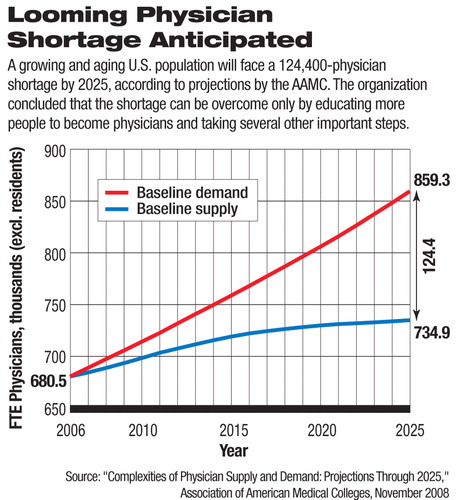The United States foresees an estimated shortage of between 37,800 and 124,000 physicians by 2034, including shortfalls in both primary and specialty care. Currently, more than 83 million people in the US live in areas in which access to a primary care physician is scarce. Primary care is the foundation of the health care system, however, thousands of people struggle to find primary care physicians or have to wait longer than usual to be checked by a physician. This is due to the increasing demand for physicians which has impacted a multitude of people throughout the country.
One of the factors that led to the increasing shortage of physicians is the journey to become a physician. There is an increase in demand for physicians, but there is a relatively fixed supply in the physician labor market. This is because training new physicians is a time-consuming and expensive process, and there are only so many medical schools in the US. with so many seats, and which have not kept up with the rising demand for physicians. This extended training period can defer potential students from pursuing a medical career or delay the entry of new physicians into practice.
In addition to the extensive training needed to become a physician, substantial disparities between what primary care physicians earn relative to specialists like orthopedists and cardiologists can weigh into medical students’ decisions about which field to choose. As a result of those pay disparities, and the punishing workload typically faced by primary care physicians, more new doctors are becoming specialists, often leaving patients with fewer choices for primary care. The United States has underinvested in primary care, as it accounted for less than 5% of healthcare spendings in 2020.
Another factor is the increase in physician burnout which has led to many physicians wanting to retire earlier. Even before COVID-19, health systems and hospitals faced widespread staffing shortages. But the pandemic pushed many healthcare providers to the point of feeling burnt out. The demanding nature of medical training and practice, coupled with administrative burdens, can contribute to burnout among physicians. This has led to early retirement or a decrease in the number of hours worked by practicing physicians. According to a March 2021 survey conducted by Merritt Hawkins for the Physicians Foundation, 38% of physicians said they would like to retire in the next year. Physicians are too afraid to admit that they are feeling overwhelmed by their job because they think it will affect their medical license. However,all people including physicians must also have the ability to focus on their mental health.They should be able to have reasonable working hours and take breaks when they need.
Overall, while specialized healthcare is important, primary care is equally as important as it ensures that people are on the right track to having healthy, high-quality lives.. The increasing shortage of primary care physicians, not only impacts individual health, but also strains the healthcare system as a whole.



